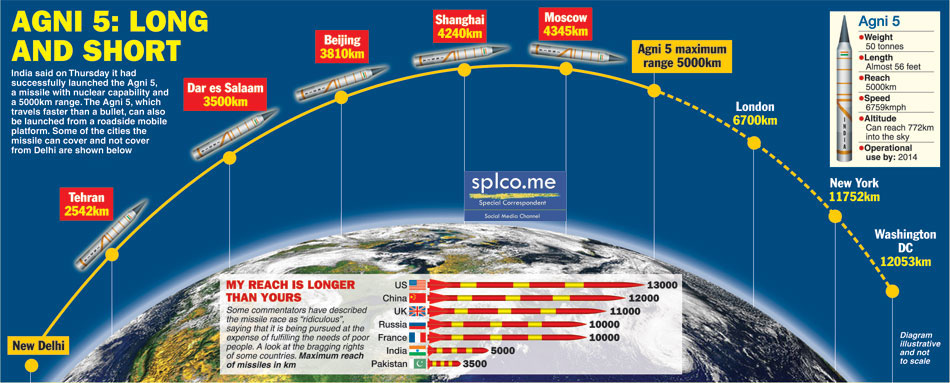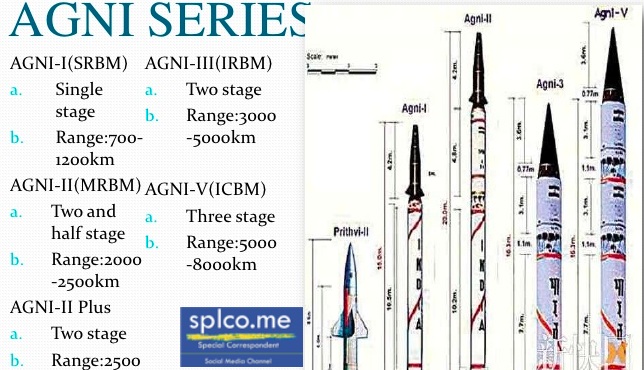China said on Tuesday it is willing to question India's successful launch of Agni-V+ ballistic missile at the United Nations Security Council. It is one of the five permanent members of UNSC.
"The UN Security Council has explicit regulations on whether India can develop ballistic missiles capable of carrying nuclear weapons," Hua Chunying, spokesperson of the Chinese foreign ministry said. She did not specify if Beijing would actually invoke these rules, perhaps hoping that Indian diplomats would react sharply.
The ministry disclosed its concern about reports in the Indian and Japanese media speculating that Agni-V is meant to counter China+ . "They need to ask the Indian side for their intention behind the move," she said referring to the media.
Let us go through the timeline of AGNI V
The Former Indian defence minister A. K. Antony, addressing the annual DRDO awards ceremony, asked defence scientists to demonstrate the 5,000-kilometre (3,100 mi) missile's capability at the earliest opportunity.
DRDO chief V. K. Saraswat told media in mid-2011 that DRDO had tested the three solid-propellant composite rocket motor stages of Agni-V independently and all ground tests had been completed.

In September 2011, Saraswat confirmed that the first test flight would be conducted in 2012 from Wheeler Island off the Orissa coast.In February 2012, a source revealed that DRDO was almost ready for the test, but there were scheduling and logistical issues since the missile was to traverse halfway across the Indian Ocean.
Countries like Indonesia and Australia as well as international air and maritime traffic in the test zone had to be alerted 7– 10 days before the test. Moreover, Indian Navy warships, with DRDO scientists and tracking and monitoring systems, were to be positioned midway and near the impact point in the southern Indian Ocean.
First test launch
On 19 April 2012 at 08.05 am, the Agni V was successfully test-fired by DRDO from Wheeler Island off the coast of Orissa. at Wheeler Island using a rail mobile launcher.The missile re-entry vehicle subsequently impacted the pre-designated target point more than 5,000 kilometres (3,100 mi) away in the Indian Ocean.The director of the test range, S.P. Das, informed BBC that all test parameters were met.
Second test launch On September 15, 2013 India conducted a second test flight of Agni-V from the Wheeler Island off Odisha coast. The missile was test-fired from a mobile launcher from Launch Complex 4 of the Integrated Test Range (ITR) at about 8:50 am. The flight duration was little over 20 minutes and hit the pre-designed target in the Indian Ocean with an accuracy of a few metres.
Third test launch
On 31 January 2015, India conducted a third successful test flight of the Agni-V from the Wheeler Island facility. The test used a canisterised version of the missile, mounted over a Tatra truck . The Integrated Test Range Director, M. V. K. V. Prasad, said: "The missile, witnessed a flawless 'auto launch' and detailed results will be known after all data is retrieved from different radars and network systems.
Fourth test launch
On 26 December 2016, a fourth test of the missile was successfully conducted from complex 4 of Wheeler Island, Odisha at 11.05 IST. This was the second canisterised test of the missile and will now pave way for user trials of the missile by the Strategic Forces Command (SFC)
President Pranab Mukherjee congratulated the Defence Research and Development Organisation (DRDO) for the successful launch. "Congratulations DRDO for successfully test firing Agni-V. It will enhance our strategic and deterrence capabilities," Mukherjee said in a tweet.
"Successful test firing of Agni-V makes every Indian very proud. It will add tremendous strength to our strategic defence," Prime Minister Narendra Modi also tweeted.
your reviews / critics are valuable to us . your news making skills can also be jointly done in our novel unique social media news making platform kindly get in touch with our team who vows to bring news told in its pure kind from splco Social Media channel for deserved people.


Comments
Comment on this article: